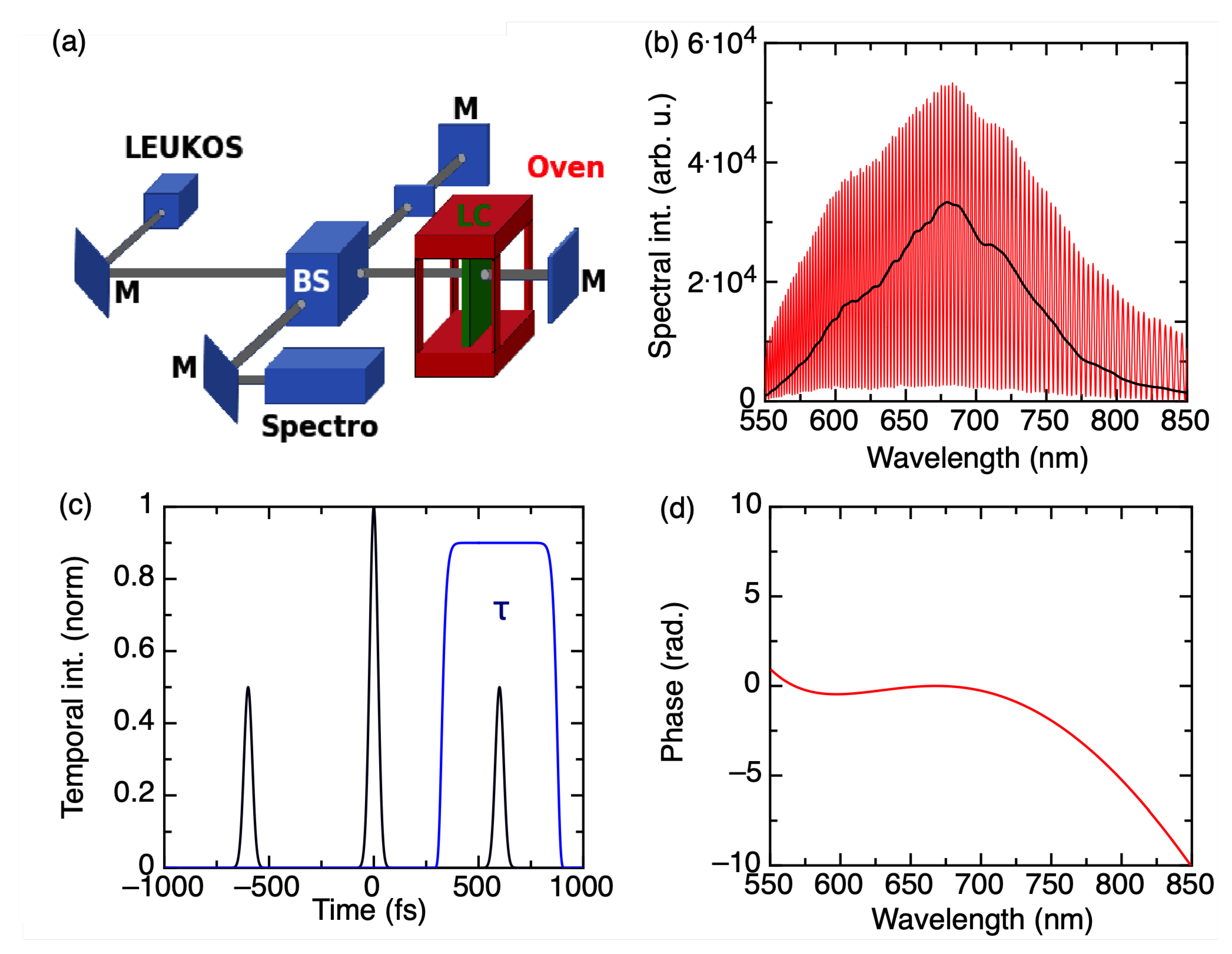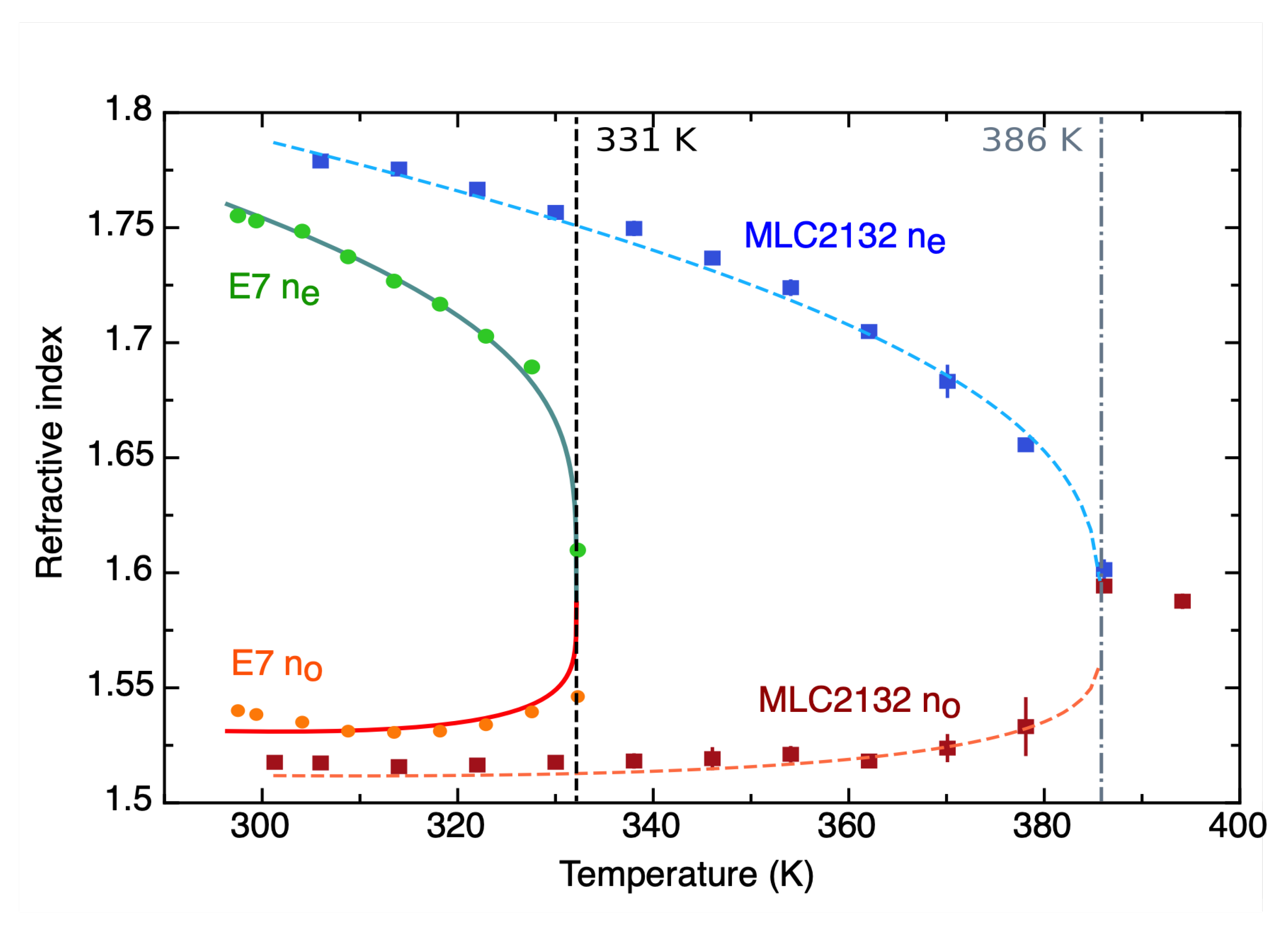Broadband Spectral Domain Interferometry for Optical Characterization of Nematic Liquid Crystals
Abstract
:1. Introduction
2. Materials and Methods
2.1. Liquid-Crystal Cells
2.2. Experimental Set-Up and Analysis
3. Chromatic Index Variation of
3.1. Principle
3.2. Experimental Results and Dispersion Coefficients
3.3. Extended Cauchy Coefficients
4. Thermotropic Characterization of
4.1. Principle
4.2. Results
5. Conclusions
Author Contributions
Funding
Conflicts of Interest
References
- De Gennes, P.G.; Prost, J. The Physics of Liquid Crystals; Oxford Science Publications: Oxford, UK, 1993. [Google Scholar]
- Khoo, I.-C. Liquid Crystals, Physical Properties and Nonlinear Optical Phenomena; Wiley: Hoboken, NJ, USA, 1995. [Google Scholar]
- DiPietro, V.M.; Jullien, A.; Bortolozzo, U.; Forget, N.; Residori, S. Dynamical optical response of nematic liquid crystal cells through electrically driven Freedericksz transition: Influence of the nematic layer thickness. Opt. Exp. 2018, 26, 10716. [Google Scholar] [CrossRef]
- Melnyk, O.; Garbovskiy, Y.; Bueno-Baques, D.; Glushchenko, A. Electro-Optical Switching of Dual-Frequency Nematic Liquid Crystals: Regimes of Thin and Thick Cells. Crystals 2019, 9, 314. [Google Scholar] [CrossRef] [Green Version]
- Chen, C.-Y.; Hsieh, C.-F.; Lin, Y.-F.; Pan, R.-P.; Pan, C.-L. Magnetically tunable room-temperature 2π liquid crystal terahertz phase shifter. Opt. Express 2004, 12, 2625–2630. [Google Scholar] [CrossRef] [PubMed]
- Yang, C.-S.; Tang, T.-T.; Chen, P.-H.; Pan, R.-P.; Yu, P.; Pan, C.-L. Voltage-controlled liquid-crystal terahertz phase shifter with indium-tin-oxide nanowhiskers as transparent electrodes. Opt. Lett. 2014, 39, 2511–2513. [Google Scholar] [CrossRef] [PubMed]
- Jullien, A.; Pascal, R.; Bortolozzo, U.; Forget, N.; Residori, S. High-resolution hyperspectral imaging with cascaded liquid crystal cells. Optica 2017, 4, 400. [Google Scholar] [CrossRef]
- Shmilovich, S.; Oiknine, Y.; AbuLeil, M.; Abdulhalim, I.; Blumberg, D.G.; Stern, A. Dual-camera design for hyperspectral and panchromatic imaging, using a wedge shaped liquid crystal as a spectral multiplexer. Sci. Rep. 2020, 10, 3455. [Google Scholar] [CrossRef] [Green Version]
- Hegyi, A.; Martini, J. Hyperspectral imaging with a liquid crystal polarization interferometer. Opt. Exp. 2015, 23, 28742. [Google Scholar] [CrossRef]
- August, I.; Oiknine, Y.; AbuLeil, M.; Stern, A. Miniature Compressive Ultra-spectral Imaging System Utilizing a Single Liquid Crystal Phase Retarder. Nat. Sci. Rep. 2016, 6, 23524. [Google Scholar] [CrossRef]
- Jullien, A.; Bortolozzo, U.; Grabielle, S.; Huignard, J.-P.; Forget, N.; Residori, S. Continuously tunable femtosecond delay-line based on liquid crystal cells. Opt. Exp. 2016, 24, 14483. [Google Scholar] [CrossRef]
- Laberdesque, R.; Jullien, A.; Bortolozzo, U.; Forget, N.; Residori, S. Tunable angular shearing interferometer based on wedged liquid crystal cells. Appl. Opt. 2017, 56, 8656–8662. [Google Scholar] [CrossRef] [PubMed]
- Ge, S.; Chen, P.; Shen, Z.; Sun, W.; Wang, X.; Hu, W.; Zhang, Y.; Lu, Y. Terahertz vortex beam generator based on a photopatterned large birefringence liquid crystal. Opt. Express 2017, 25, 12349–12356. [Google Scholar] [CrossRef] [PubMed] [Green Version]
- Chen, C.-W.; Guo, X.; Ni, X.; Lin, T.-H.; Khoo, I.C. Slowing sub-picosecond laser pulses with 0.55 mm-thick cholesteric liquid crystal. Opt. Mater. Exp. 2017, 7, 2005. [Google Scholar] [CrossRef]
- Neradovskiy, M.; Scarangella, A.; Jullien, A.; Mitov, M. Dispersion of 20 fs pulses through bandgap edges of cholesteric liquid crystals. Opt. Express 2019, 27, 21794. [Google Scholar] [CrossRef]
- Di Pietro, V.M.; Jullien, A.; Bortolozzo, U.; Forget, N.; Residori, S. Thermally-induced nonlinear spatial shaping of infrared femtosecond pulses in nematic liquid crystals. Laser Phys. Lett. 2019, 16, 015301. [Google Scholar] [CrossRef] [Green Version]
- Di Pietro, V.M.; Bux, S.; Forget, N.; Jullien, A. Phase-only pulse shaper for multi-octave light sources. Opt. Lett. 2020, 45, 543–546. [Google Scholar] [CrossRef]
- Humar, M.; Musevic, I. 3D microlasers from self-assembled cholesteric liquid-crystal microdroplet. Opt. Express 2010, 18, 26995–27003. [Google Scholar] [CrossRef] [Green Version]
- Mirri, G.; Skarabot, M.; Musevic, I. In situ laser-imprinted surface realignment of a nematic liquid crystal. Soft Matter 2015, 11, 3347. [Google Scholar] [CrossRef] [Green Version]
- Li, J.; Wu, S.-T. Extended Cauchy Equations for the Refractive Indices of Liquid Crystals. J. Appl. Phys. 2004, 95, 896–901. [Google Scholar] [CrossRef] [Green Version]
- Li, J.; Gauza, S.; Wu, S.-T. Temperature effect on liquid crystal refractive indices. J. Appl. Phys. 2004, 96, 19–24. [Google Scholar] [CrossRef]
- Brugioni, S.; Faetti, S.; Meucci, R. Mid-infrared refractive indices of the nematic mixture E7. Liq. Cryst. 2003, 30, 927–930. [Google Scholar] [CrossRef]
- Warenghem, M.; Joly, G. Liquid crystal refractive indices behavior versus wavelength and temperature. Mol. Cryst. Liq. Cryst. 1991, 207, 205–218. [Google Scholar] [CrossRef]
- Vaz, N.A.; Smith, G.W.; Montgomery, G.P.; Marion, W.D. Refractive indices of a Methylstilbene polymer liquid crystal. Mol. Cryst. Liq. Cryst. 2001, 198, 305–321. [Google Scholar] [CrossRef]
- Wu, S.-T.; Efron, U.; Hess, L.D. Birefringence measurements of liquid crystals. Appl. Opt. 1984, 23, 3911. [Google Scholar] [CrossRef] [PubMed]
- Rivet, S.; Bradu, A.; Bairstow, F.; Forrière, H.; Podoleanu, A. Group refractive index and group velocity dispersion measurement by complex master slave interferometry. Opt. Express 2018, 26, 21831. [Google Scholar] [CrossRef]
- Sorin, W.V.; Gray, D.F. Simultaneous Thickness and Group Index Measurement Using Optical Low- Coherence Reflectometry. IEEE Phot. Technol. Lett. 1992, 4, 105. [Google Scholar] [CrossRef]
- Michaeli, L.; Haim, D.B.; Sharma, M.; Sucowski, H.; Ellenbogen, T. Spectral interferometric microscopy for fast and broadband phase characterization. Adv. Opt. Mater. 2020, 2000326. [Google Scholar] [CrossRef]
- Moulet, A.; Grabielle, S.; Cornaggia, C.; Forget, N.; Oksenhendler, T. Single-shot, high-dynamic-range measurement of sub-15 fs pulses by self-referenced spectral interferometry. Opt. Lett. 2010, 35, 3856. [Google Scholar] [CrossRef]
- Shen, X.; Wang, P.; Liu, J.; Kobayashi, T.; Li, R. Self-Referenced Spectral Interferometry for Femtosecond Pulse Characterization. Appl. Sci. 2017, 7, 407. [Google Scholar] [CrossRef] [Green Version]
- Jun, L. Refractive Indices of Liquid Crystals and Their Applications in Display and Photonic Devices. Ph.D. Thesis, University of Central Florida, Orlando, FL, USA, 2005. [Google Scholar]
- Li, J.; Wen, C.H.; Gauza, S.; Lu, R.; Wu, S.T. Refractive Indices of Liquid Crystals for Display Applications. J. Display Technol. 2005, 1, 51. [Google Scholar] [CrossRef]
- Lepetit, L.; Cheriaux, G.; Joffre, M. Linear techniques of phase measurement by femtosecond spectral interferometry for applications in spectroscopy. J. Opt. Soc. Am. B 1995, 12, 2467–2474. [Google Scholar] [CrossRef]
- Borzsonyi, A.; Kovács, A.P.; Osvay, K. What We Can Learn about Ultrashort Pulses by Linear Optical Methods. Appl. Sci. 2013, 3, 515. [Google Scholar] [CrossRef] [Green Version]
- Vuks, M.F. Determination of Optical Anisotropy of Aromatic Molecules from Double Refraction in Crystals. Opt. Spectrosc. 1966, 20, 361. [Google Scholar]
- Haller, I. Thermotropic and static properties of liquid crystals. Prog. Solid State Chem. 1975, 10, 103–118. [Google Scholar] [CrossRef]
- Singh, S. Phase transitions in liquid crystals. Phys. Rep. 2000, 324, 24. [Google Scholar] [CrossRef]




| = 750 nm | [31] | [31] | ||||
|---|---|---|---|---|---|---|
| 337 | 158 | 1 | 6 | 338 | 318 | |
| 126 | 20 | 2 | 7 | 125 | 69 | |
| 387 | 231 | 2 | 9 | |||
| 124 | 69 | 1 | 3 |
| A | B | C | ||||
|---|---|---|---|---|---|---|
| 1.687 | 0.005 | 0.0079 | 0.0001 | 0.0027 | 0.0001 | |
| 1.495 | 0.005 | 0.0073 | 0.0001 | 0.0004 | 0.0001 | |
| [31] | 1.6933 | 0.0078 | 0.0028 | |||
| [31] | 1.499 | 0.0072 | 0.0003 | |||
| 1.712 | 0.001 | 0.0095 | 0.0001 | 0.0032 | 0.0001 | |
| 1.487 | 0.001 | 0.0072 | 0.0001 | 0.0003 | 0.0001 |
| D | E | ||||
|---|---|---|---|---|---|
| 1.7546 | 0.000536 | 0.3768 | 0.2391 | 331 | |
| 1.713 | 0.00038 | 0.45 | 0.356 | 386 | |
| 0.01 | 0.00002 | 0.01 | 0.005 | 1 |
© 2020 by the authors. Licensee MDPI, Basel, Switzerland. This article is an open access article distributed under the terms and conditions of the Creative Commons Attribution (CC BY) license (http://creativecommons.org/licenses/by/4.0/).
Share and Cite
di Pietro, V.M.; Jullien, A. Broadband Spectral Domain Interferometry for Optical Characterization of Nematic Liquid Crystals. Appl. Sci. 2020, 10, 4701. https://doi.org/10.3390/app10144701
di Pietro VM, Jullien A. Broadband Spectral Domain Interferometry for Optical Characterization of Nematic Liquid Crystals. Applied Sciences. 2020; 10(14):4701. https://doi.org/10.3390/app10144701
Chicago/Turabian Styledi Pietro, Vittorio Maria, and Aurélie Jullien. 2020. "Broadband Spectral Domain Interferometry for Optical Characterization of Nematic Liquid Crystals" Applied Sciences 10, no. 14: 4701. https://doi.org/10.3390/app10144701





